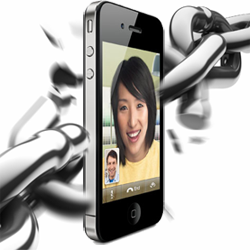Over at Ars, Ken, Jacqui, and Clint have written their magnum opus on the iPhone. On page 9 (yes, the review is more than 10 pages long), we get an interesting tidbit about the visual voicemail feature:
Visual voicemail is a new feature introduced by AT&T and Apple with the iPhone that currently only “works” over AT&T’s network. Instead of requiring the user to dial up the carrier’s voicemail number and listen to his or her voicemails in the order that they were received, visual voicemail lists each message out in visual format on the iPhone, almost like e-mail. It displays who the voicemail is from (and if it doesn’t recognize the number, it will analyze the area code and tell you what geographical area it’s from, which is helpful), and the user can tap whichever one in the list that he or she wants, no matter its position in the list. When the voicemail is playing, the user can pause it, scrub back and forth in the message, or skip.
The way it works is actually not as magical as AT&T might like you to believe, although the technology is still AT&T-specific. The iPhone actually downloads sound clips of the voicemail messages off of AT&T’s server, presumably over EDGE, and stores them in temporary files on the iPhone’s flash storage. This allows the iPhone user to select messages to listen to out of order, because all he or she is doing is listening to an audio file. This is also what enables the user to scrub with the touchscreen and listen to different parts of the message. It’s a nifty bit of technology, but really only required AT&T’s voicemail servers to tell the iPhone when to download a new message, and then the iPhone takes care of the rest. In our tests, visual voicemail worked as advertised, and we had no trouble with it. It is, however, a feature that we would be more than willing to sacrifice if we had the opportunity to use an unlocked iPhone on another network. That said, Ken believes that this is a very significant development in the world of voicemail, and he hopes and prays that this becomes standard everywhere.
This is a question we’ve discussed several times here: how much special support is required on the network side to make visual voicemail work? The answer seems to be “some, but not as much as you might think.” That is, the network does have to notify the phone of when new messages are available, provide them for download to the phone, and accept status change notifications from the phone when the user has listened to or deleted them. But there doesn’t need to be tight integration between the phone and the network when the user is actually listening to the messages.
Come to think of it, another advantage this approach presumably has is that you shouldn’t have to be connected to the network to listen to your voicemail messages. Once they’re downloaded to your phone, you should be able to listen to them anywhere, even if you’re in a location that doesn’t get good reception.

 Don’t look now, but it may be time to dig out those old bell bottoms and love beads from your closet. The calendar may say its 2007, but in Washington regulatory circles it may soon be
Don’t look now, but it may be time to dig out those old bell bottoms and love beads from your closet. The calendar may say its 2007, but in Washington regulatory circles it may soon be  It hasn’t even been a week since Tim Wu made such a splash with his “
It hasn’t even been a week since Tim Wu made such a splash with his “
 The Technology Liberation Front is the tech policy blog dedicated to keeping politicians' hands off the 'net and everything else related to technology.
The Technology Liberation Front is the tech policy blog dedicated to keeping politicians' hands off the 'net and everything else related to technology.